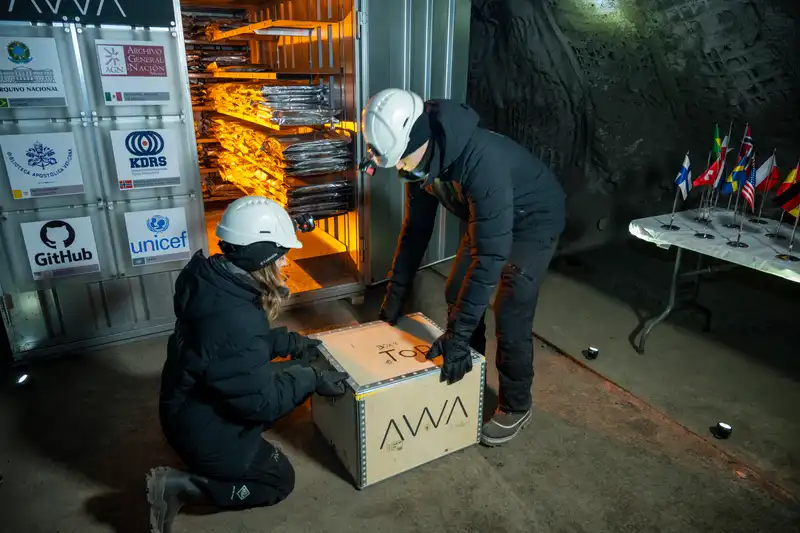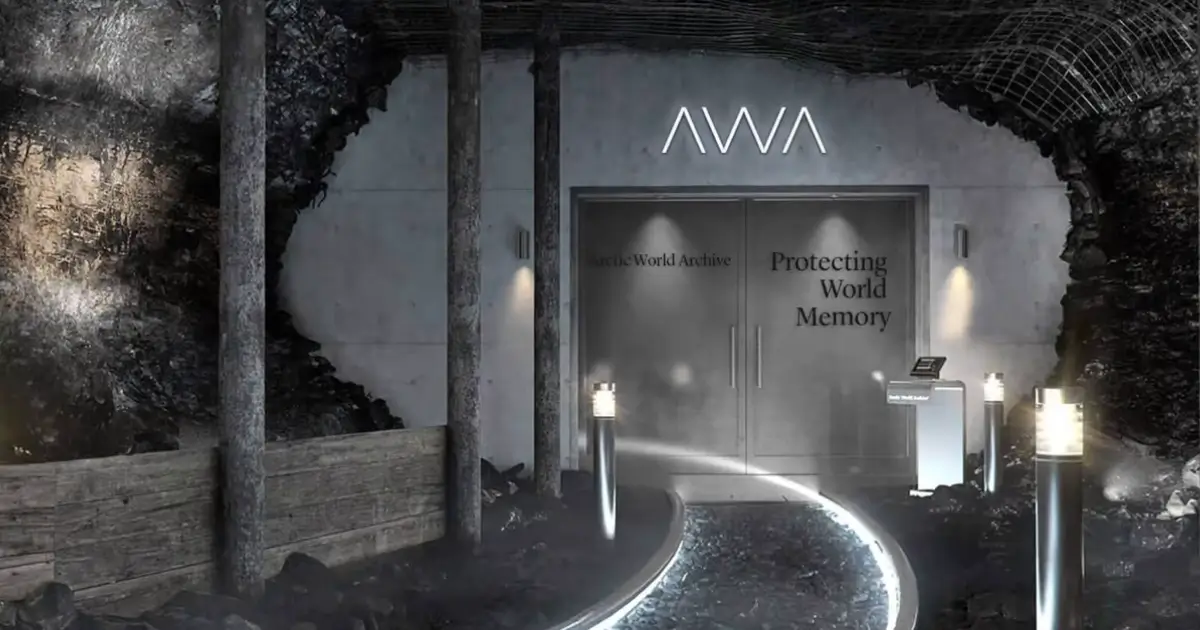Deep beneath the icy grip of the Arctic tundra lies a revolutionary data vault: the Arctic World Archive (AWA). This isn’t your ordinary server farm. Instead of humming machines and relentless heat generation, the AWA is a disused coal mine. The facility cradles humanity’s digital heritage, from cultural artifacts to critical code to essential preservation data, ensuring our digital legacy endures for future generations.
The Arctic World Archive: Everything There Is to Know
The AWA data vault stands in stark contrast to traditional methods like cloud storage, external hard drives, and flash drives, all susceptible to failure or obsolescence within a few decades.
Unlike traditional methods with limited lifespans, Piql film offers a secure way to store invaluable data for centuries, well beyond our life span. The AWA offers a long-term solution, safeguarding our digital heritage for future generations. Find out how it utilizes Piql film, a groundbreaking storage medium that encodes digital information for long-term data storage, potentially lasting over 1,000 years.

The AWA uses nature in favor of preserving its precious hardware.
What makes the AWA so audacious?
It’s all about defying the ever-changing nature of technology with a two-pronged strategy:
- Location, Location, Location: Svalbard boasts permafrost, a layer of ground eternally frozen, offering a naturally cool and stable environment – a stark contrast to data centers constantly battling overheating servers.
- Future-Proofing Data: Forget the limitations of magnetic tapes and hard drives with their built-in obsolescence. The AWA utilizes Piql film, a groundbreaking technology that encodes data onto photosensitive film. With a staggering shelf life exceeding 1,000 years, Piql film is a true champion of archival longevity.
- Data Security: Crucially, the AWA’s stored offline nature offers superior protection against disasters compared to online storage solutions vulnerable to cyberattacks or outages.
But don’t just take our word for it! Dive into this interview by NBS to witness their incredible film technology in action:
Real-World Impact: Preserving More Than Memes
The AWA isn’t just about safeguarding your vacation photos (although, we can’t deny the historical significance of documenting the ever-popular grumpy cat!). Here are some of the invaluable treasures entrusted to its care:
- A treasure trove of open-source code from Github: This ensures that future programmers have access to the building blocks of the software that shapes our digital world today. A staggering 21 terabytes of data, including modeling systems, apps, and website designs, were transferred from Github back in 2020 – requiring a whopping 186 rolls of film.
- Cultural artifacts of immense significance: National Geographic documentaries, the irreplaceable languages of Brazilian indigenous tribes, and even the very foundation of Mexico’s legal system – the Mexican constitution – all find a safe haven within the AWA’s walls.

The crew at AWA has priceless information to maintain.
A Glimpse into the Technological Frontier
But from a technical perspective, how does the Arctic World Archive daringly change Data Storage? Well, it disrupts traditional data storage in 3 different ways.
- Traditional data storage relies on magnetic or electrical properties of physical media (hard drives, tapes). These degrade over time and become unreadable within decades.
- The AWA utilizes Piql film, a revolutionary approach. Data is converted into binary code (1s and 0s) and then encoded onto a photosensitive layer similar to traditional photographic film.
- This method boasts a shelf life exceeding 1,000 years, a significant leap compared to magnetic media.

- Modern technology thrives on constant innovation, often rendering existing hardware and software obsolete within a few years.
- Traditional data storage solutions often require frequent migration to newer formats to prevent data loss due to obsolescence. This process can be complex and costly.
- The AWA takes a long-term approach. Piql film offers a future-proof solution, potentially lasting for centuries. While the technology used to create the data might be long gone, Piql is actively researching methods for future generations to decode the film itself.

- Traditional data security relies on complex software and encryption protocols, vulnerable to hacking and potential software vulnerabilities.
- The AWA takes a hardware-centric approach. The data itself is encoded onto the Piql film, making it inherently more secure and less susceptible to hacking compared to digital storage solutions.


Nicknamed the ‘Doomsday Archive’, AWA brings hope of endurance beyond the unforeseeable future
8 Lessons from the AWA for Software Teams: A Multifaceted Approach
The Arctic World Archive offers valuable insights for software teams across various departments – from business and product strategy to engineering and customer success. Let’s explore how:
Business & Product |
|
|---|---|
Software Engineering |
|
Customer Success |
|
Additional Considerations |
|
By taking inspiration from the AWA’s innovative approach, software teams can build products with greater longevity, user focus, and environmental responsibility.
Building software with long-term vision requires a skilled team. Ubiminds, a talent-as-a-service company, connects you with top software engineers in Latin America who share these values. Ubiminds integrates them into your remote teams, boosting performance. Leave a contact request below to hire problem-solvers to build software that endures!
The AWA: A Pioneering Force in Digital Archiving
All in all, the AWA’s innovative approach to data storage sparks intriguing questions about the future:
- How will future civilizations access this data? Piql is actively researching methods for future generations to decode their film, even if the technology that created it is a distant memory.
- Can the AWA withstand unforeseen threats? While the location offers protection from natural disasters and political unrest, what about unforeseen events like an asteroid strike? Only time will tell.
The Arctic World Archive stands as a testament to human ingenuity. By combining cutting-edge storage solutions with a geographically blessed location, the AWA offers a glimpse into a future where our digital legacy transcends the limitations of current technology. Whether it’s code, cultural heritage, or even the occasional cat video, the AWA ensures these fragments of our history have a fighting chance of surviving for centuries to come.

International Marketing Leader, specialized in tech. Proud to have built marketing and business generation structures for some of the fastest-growing SaaS companies on both sides of the Atlantic (UK, DACH, Iberia, LatAm, and NorthAm). Big fan of motherhood, world music, marketing, and backpacking. A little bit nerdy too!









